Lopholithodes
foraminatus (Stimpson,
1862)
Common name(s): Box crab, Brown box crab, Puget Sound box crab, Oregon
queen crab
|
| Synonyms: |
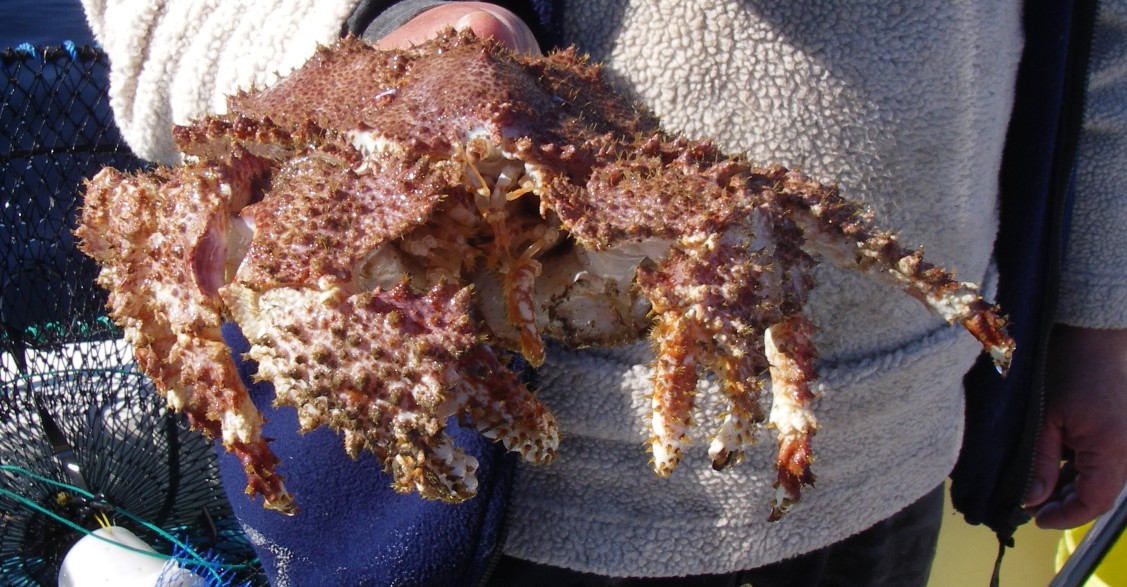 |
|
Phylum Arthropoda
Subphylum Crustacea
Class Malacostraca
Subclass Eumalacostraca
Superorder Eucarida
Order Decapoda
Suborder Pleocyemata
|
| Lopholithodes
foraminatus
caught by Joe Watson of Campbell River BC at 110-130 m depth in a crab
trap near Twin Island in the Strait of Georgia, Canada. This
is a
large male. The distinctive foramen
created by the legs can be seen to the left, between the base of the chela
and the next leg, lined with smooth purple and white cuticle. |
| (Photo by: Will Duguid,
University of Victoria) |
Description:
The most distinctive
feature of large lithodid crab is the fact that when it pulls its legs
under itself and folds its claws across its front, as it often does, a
large notch on the carpus
of its chelipeds
combined with a smaller notch on the carpus
of leg 2 lie beside each other, creating a prominent tubelike opening
presumably
used for breathing. Other features include the fact that its
abdomen
is completely calcified and its legs are not markedly longer than the carapace.
The carapace
has tubercles
with sharp spines and has no pronounced depression on the
posterodorsal
surface. It is rounded posterolaterally and does not resemble
an
equilateral triangle, and it has no lateral extensions which cover its
legs when viewed from above. The sides of the walking legs
are smooth
and fit together tightly when folded, while the dorsal surfaces have tubercles
and spines (photo).
The merus
of the chelipeds
has lateral extensions on its inner dorsal margin, and the carpus
and propodus
curve upward and cover the mouth when they are folded against the
body.
The largest cheliped
(usually the right) has large, blunt white teeth on the cutting
surface,
while the small chela
has small sharp teeth. The rostrum
is a sharp upturned spine with more spines near the base (photo),
somewhat like that of Rhinolithodes
wosnessenskii. Color is red-brown or
tan with purplish
and white areas. The chelae
are tan and mottled red, with white on the dorsal side and orange or
red
fingers and white tips. Carapace
width to 18.5 cm or larger. Maximum size in males is larger
than
that for females.
How to Distinguish
from Similar Species:
The tubelike passage (foramen) through the folded legs provides certain
identification. Lopholithodes
mandtii looks similar but it is more brightly
colored and has
blunt bumps (tubercles)
rather than bumps with spines on its carapace. Rhinolithodes
wosnessenskii and Phyllolithodes
papillosus have a deep posterodorsal depression
in their carapace. Oedignathus
inermis has a soft abdomen.
Geographical
Range: Kodiak, Alaska
to San Diego, CA
Depth
Range: Low intertidal to 547
m. Usually deep. In the Oregon offshore fishery
they are mostly
caught at 128-165 m depth.
Habitat: Soft
bottoms deeper than
18 m, or on rocky faces overlooking soft bottoms.
Biology/Natural
History: This species
is said to feed by scooping up sediment with its claws, and also to
feed
on the clams it digs up. Will Duguid reports that in the
laboratory
adults of this species are strongly attracted to and feed on brittle
stars.
They may also feed on urchins such as Strongylocentrotus
droebachiensis. It is
thought that octopus may be
its main predator. It may bury itself in the sediment, except
that
the front with the foramen is exposed for breathing. The abdomen
has knobby plates and Flora
and Fairbanks say it is also partly soft and not held very
tightly
against the thorax
(this seems to conflict with other accounts). An intermittent
open
coast fishery for this species exists off Oregon.
This species is said to occur in large aggregations of mixed males
and females on soft bottoms. Molting within an aggregation
seems
to be synchronous, but not synchronized with that of other
aggregations.
Eggs and larvae of snailfish, especially Careproctus
melanurus, the blacktail snailfish, are often found among
the gill
filaments of these crabs. These may occur in large numbers
and even
may contribute to collapse of the gills, but usually they do not seem
to
cause any harm.
Off British Columbia this species has a biennial
(two-year) cycle for
brooding. Females molt and breed during mid-summer, then
brooded
their eggs and larvae for 18 months before releasing them as zoeae
the second winter or early spring (Feb-April) after breeding.
Much
of this long brooding period was due to the fact that the brooded eggs
underwent a 12-month diapause in the gastrula stage. The
females
released the larvae gradually, averaging a period of 69 days.
Brooding
females have a mean carapace
length of 8.9 cm (width 10.7 cm) and a minimum carapace
length of 7.5 cm (width 8.8 cm). Females which have been
brooding
for a number of months and post-breeding females often have extensive
overgrowth
of polychaete tubeworms, hydrozoans, and small bivalves. The
distal
legs and much of the underside has a black stain not seen on males or
pre-incubation
females (Duguid and Page, 2011).
References:
Dichotomous Keys:
Coffin,
1952
Flora
and Fairbanks 1966
Kozloff
1987, 1996
Wicksten,
2009
General
References:
Gotshall and Laurent, 1979
Harbo,
1999
Hart,
1982
Jensen,
1995
Johnson
and Snook, 1955
Scientific Articles:
Duguid, William D.P.
and Louise R. Page, 2011.
Biennial reproduction with embryonic diapause in Lopholithodes
foraminatus
(Anomura: Lithodidae) from British Columbia waters.
Invertebrate
Biology 131:1 pp. 68-82.
Kato, S.,
1992. Box Crab. p. 192 in
W.S. Leet, C.M. Dewees, and C.W. Haugen (eds). California's
living
marine resources and their utilization. Sea Grant Extension,
University
of California, Davis, CA
Parrish, R.H.,
1972. Symbiosis in the blacktail
snailfish, Careproctus melanurus, and the box crab, Lopholithodes
foraminatus.
California Fish and Game 58(8): 239-240
Peden, A.E. and C.A.
Corbett, 1972. Commensalism
between a liparid fish, Careproctus sp. and the lithodid box crab,
Lopholithodes
foraminatus. Canadian Journal of Zoology 51: 555-556
Web sites:
General Notes and
Observations: Locations,
abundances, unusual behaviors:
This species is said to have previously been often found
in the Puget
Sound/Straits of Juan de Fuca region by SCUBA divers at depths below
15-18
m but it is now rarely seen. I have not seen one near the
Rosario
Beach Marine Laboratory but the station museum has a large specimen
captured
years ago. This species is apparently more common below SCUBA depths so
it may by near our station but found deeper than we dive.
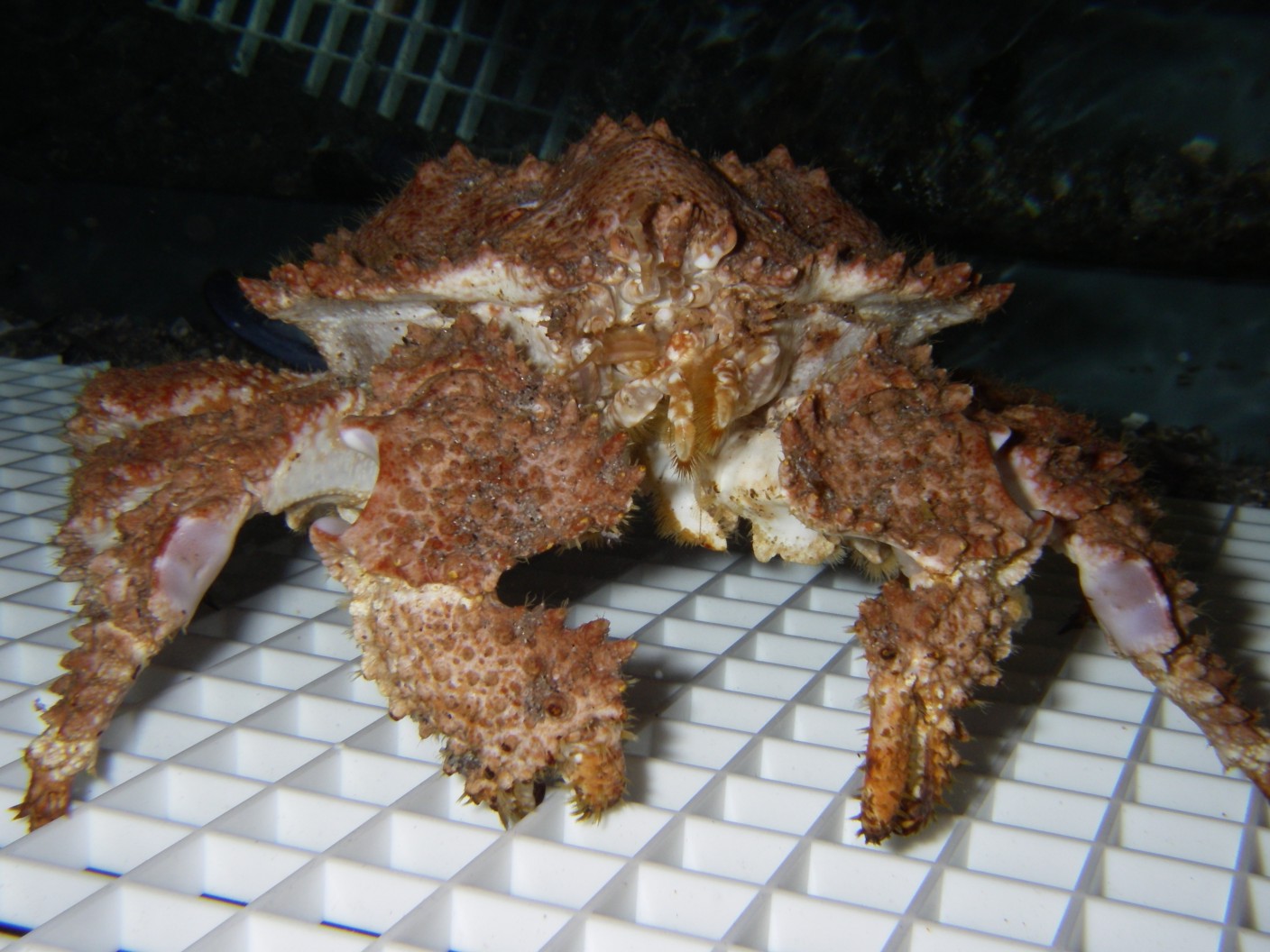
This photo of an adult is by Will Duguid
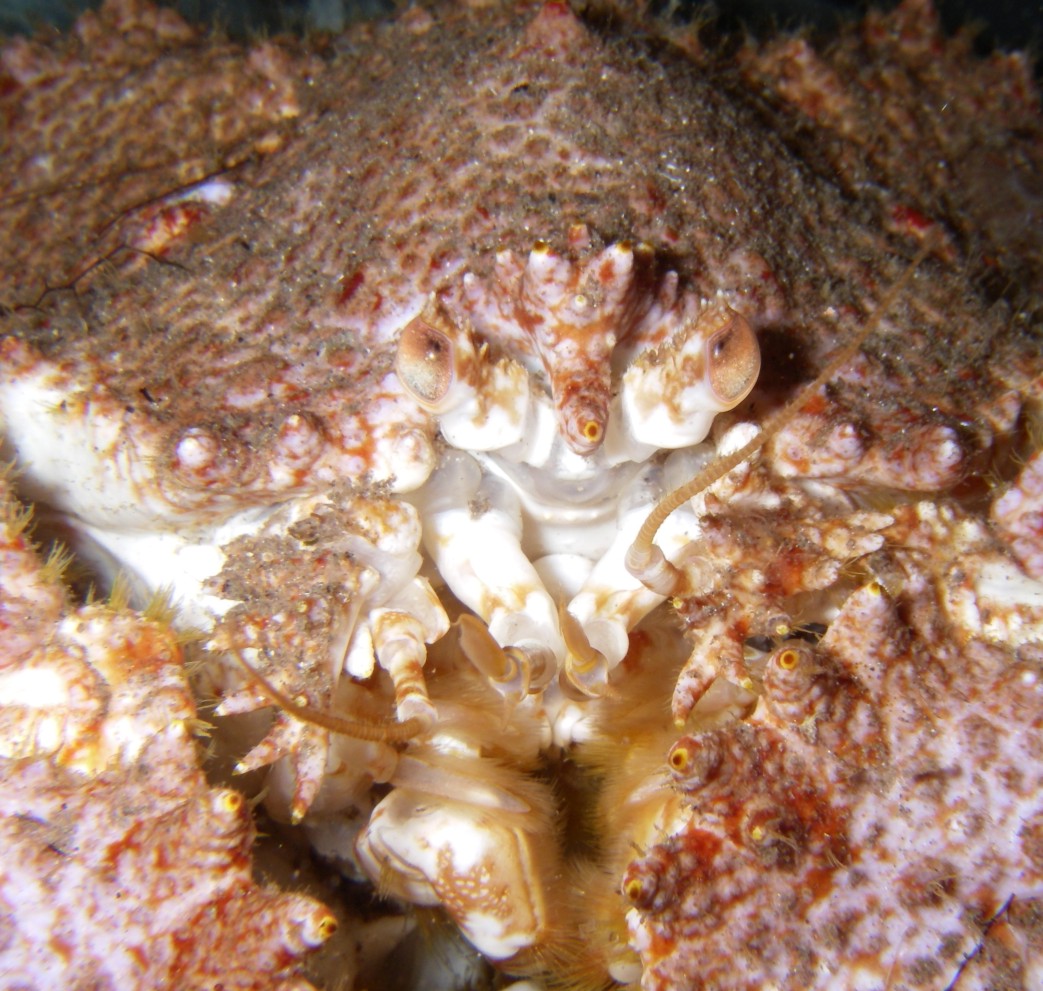
In this closeup of the face the small spinelike rostrum
can be seen. Other features include the spine-tipped tubercles
on the dorsal carapace
and on the dorsal surfaces of the legs and chelae.
Note that in Anomuran crabs the second antennae are based lateral to
the eyes, as can be seen here.
Photo by Will Duguid.
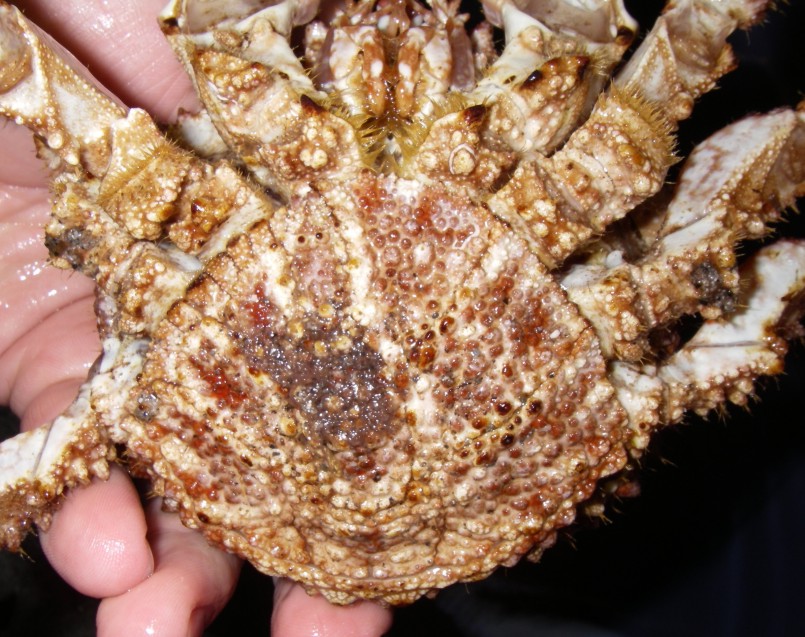
The abdomens
of adult males and females differ in several ways.
This is the abdomen
of a female, which is shown above, is broader than that of a male and
is
asymmetrical.
The plates on the left side of the female abdomen
(to the right above) are larger than those on the left.
The right side of the female abdomen
also has a row of small marginal plates but the left side does not.
The female also has pleopods
on her abdomen,
which cannot be seen without pulling the abdomen away from the thorax.
The abdomen
of a male is not as broad and is more triangular. It has a
small
row of marginal plates on both sides.
The adult male has no pleopods.
Photo by Will Duguid
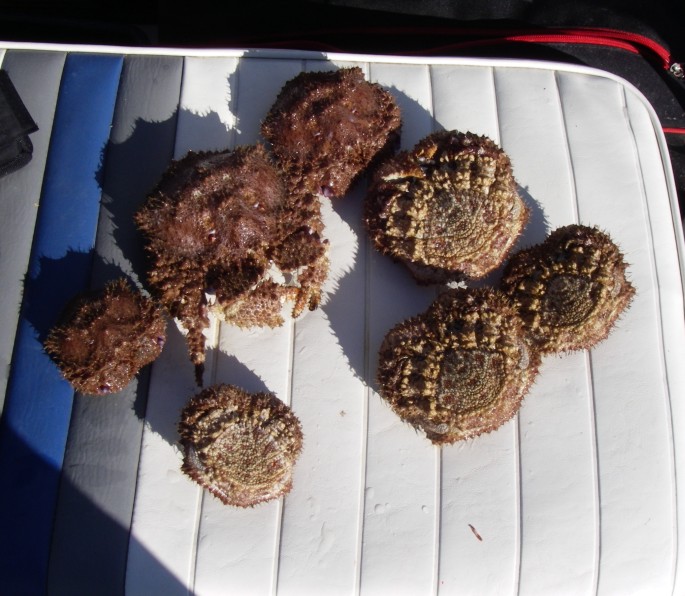
This photo helps illustrate why these crabs are called box
crabs.
When disturbed they fold their legs and abdomen
together
and hold them tightly against the body so that they are like a tight
box or ball. The crabs on the left side of the seat are
upright while those to the right are upside-down.
Photo by Will Duguid

This front view of a dried specimen shows the distinct openings for
respiratory excurrent flow formed by the front legs when they are
folded
in front of the face. This, no doubt, is the reason for the
'foraminatus'
in the species name. Photo by Dave Cowles, August 2016
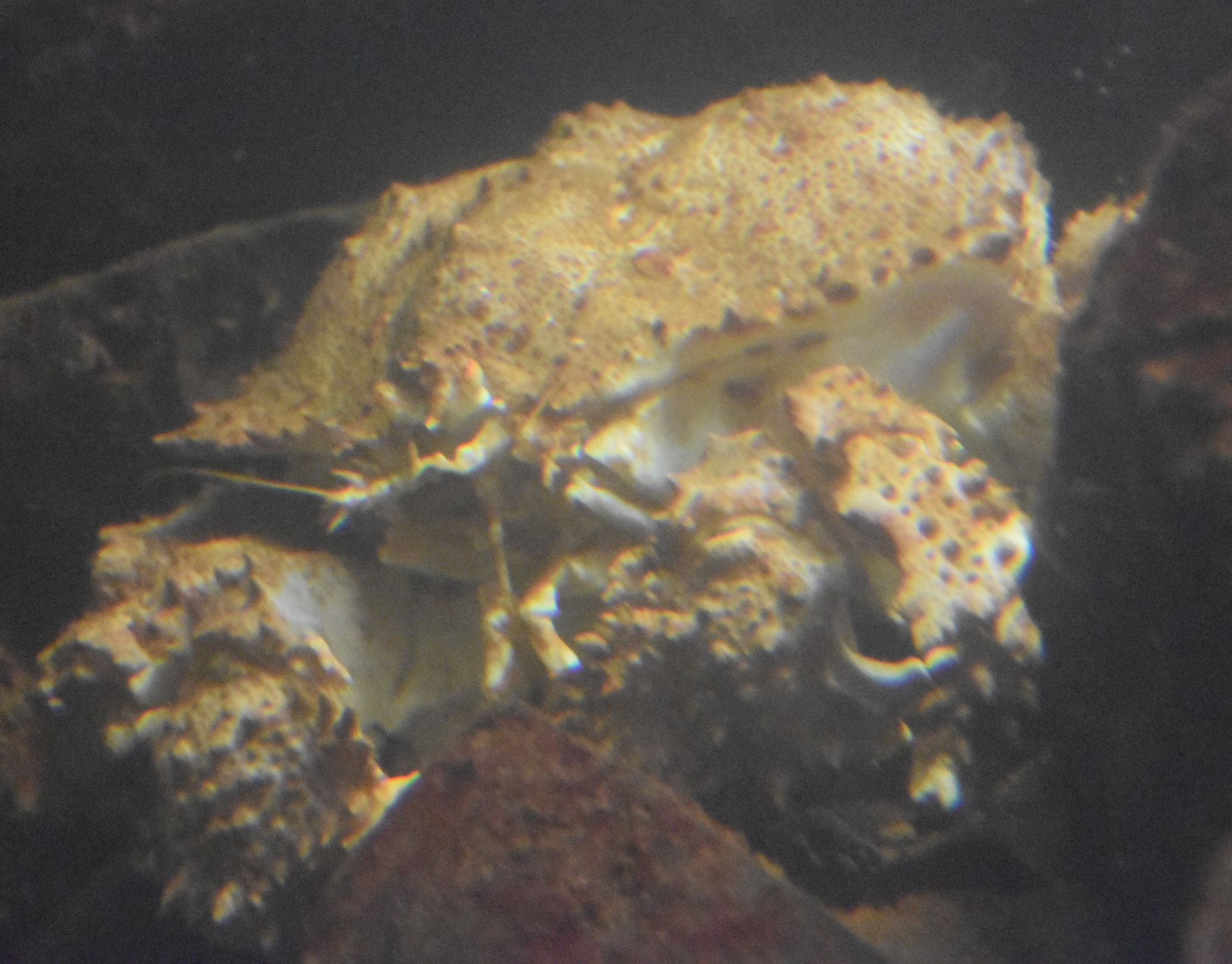
This live individual was photographed in the Seaside,
OR aquarium. Photo by Dave Cowles, August 2017
|
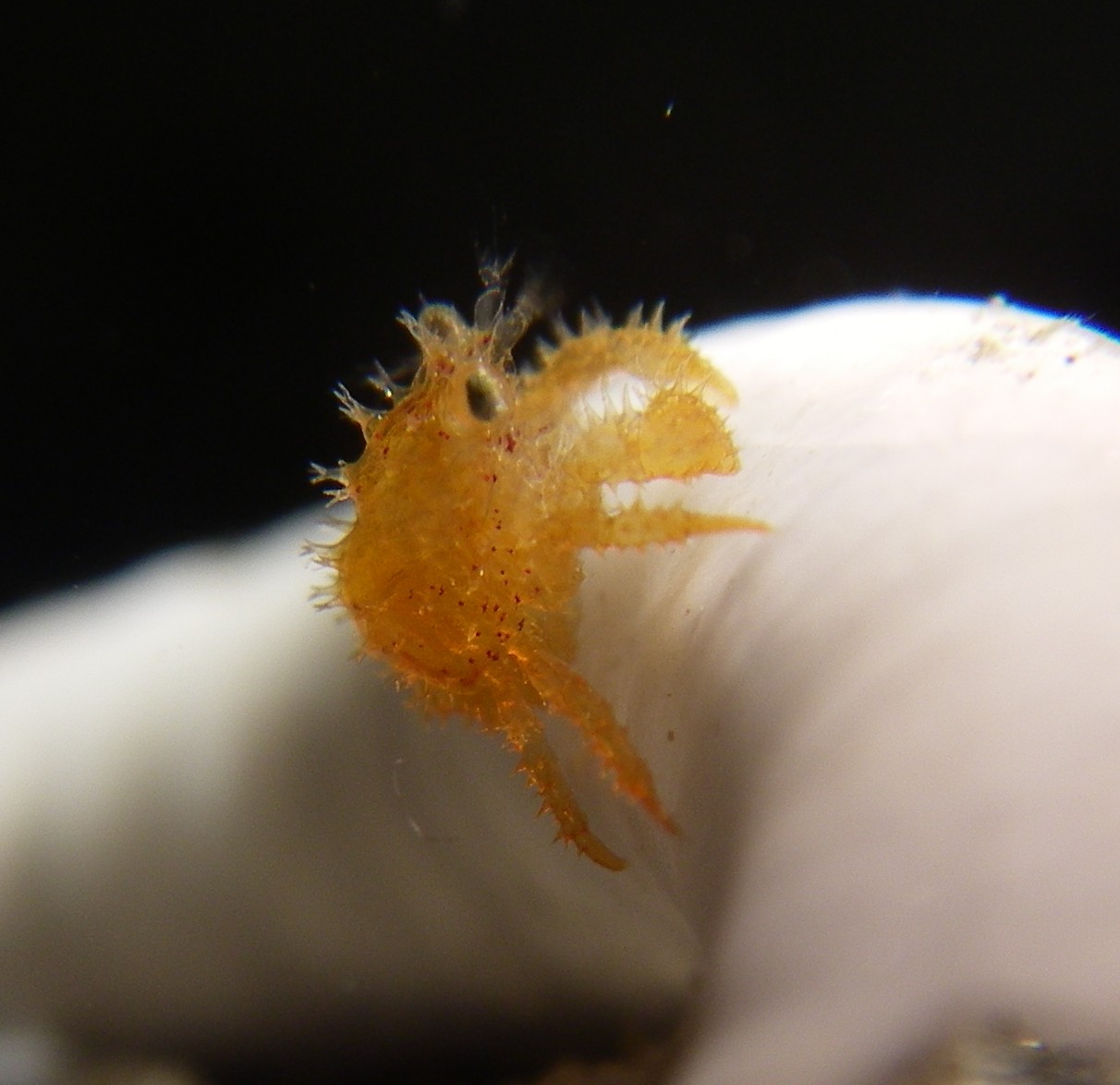 |
|
This is the glaucothoe stage. By this
stage the young crab has
a well-developed abdomen with pleopods.
It can swim with the pleopods. |
|
|
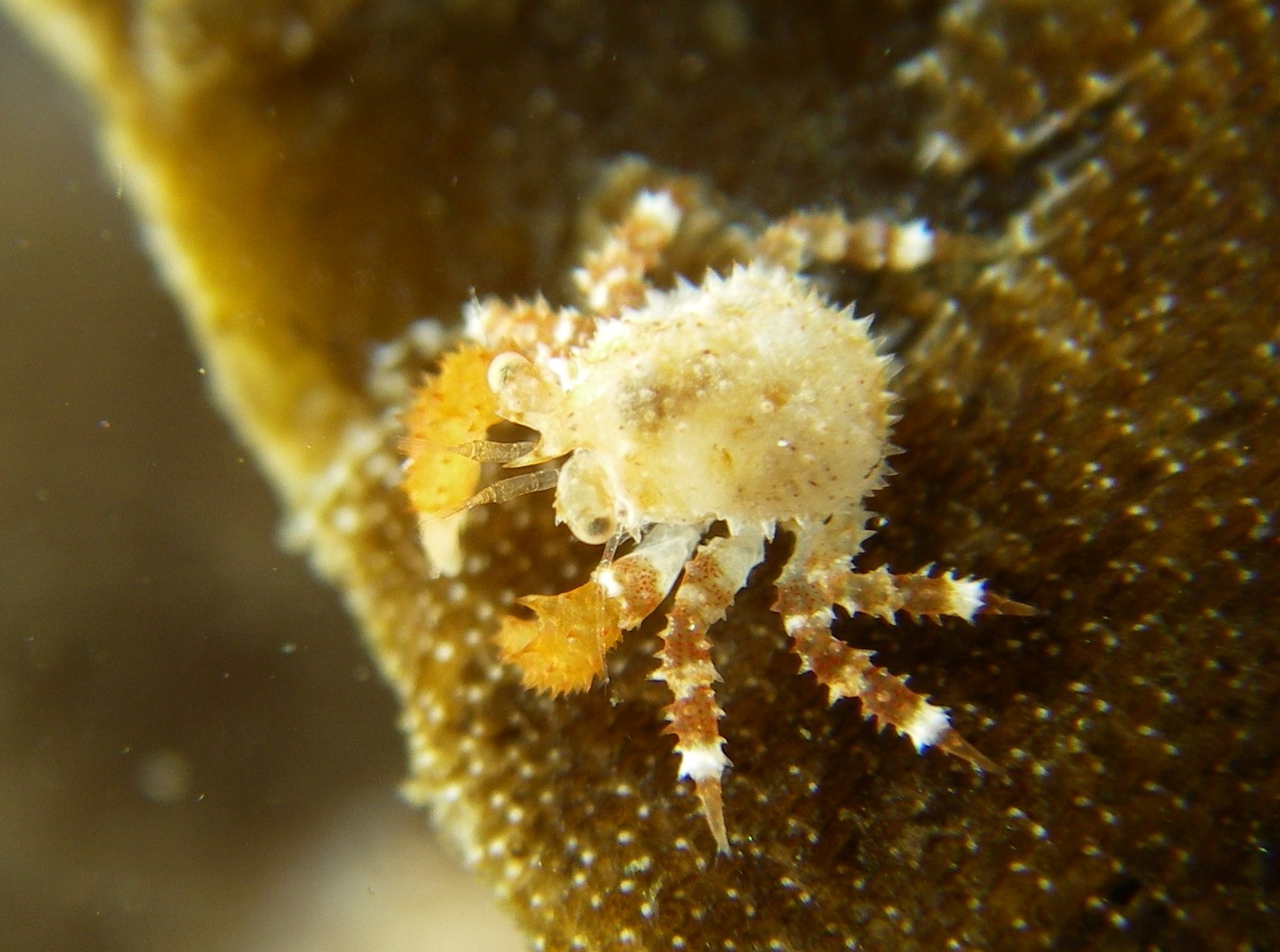 |
 |
| This crab is an instar III juvenile (3 molts past
the glaucothoe stage).
At this stage it no longer has the pleopods
it had as a glaucothoe, and it walks rather than swims. |
This young crab is an instar VI juvenile (six
molts past the glaucothoe
stage). |
| Lithodid crabs such
as Lopholithodes
foraminatus pass through the nauplius
stage before hatching from the egg. A nauplius
has only 3 appendages, which will become the first and second antennae
and the mandibles
(jaws) in the adult, but during the nauplius
stage they are paddle-like. The crab hatches from the egg as
the
first of four zoea
larva stages (instars). Zoea
larvae swim through the plankton but they do it using some extra
thoracic
appendages which they grew during the molt, called maxillipeds.
After the zoea
stages comes one glaucothoe stage, called a postlarva. The
glaucothoe
swims using pleopod
appendages which have appeared on its abdomen during its
molt. This
is similar to the way a shrimp swims. The glaucothoe molts
through
several juvenile stages which resemble an adult (they walk rather than
swim) but are much smaller. Interestingly, in the molt from
glaucothoe
to juvenile the young crab loses its pleopod
appendages. After several juvenile stages the crab becomes a
sexually
mature adult. In adults of this species the males have no pleopods
but the females re-form pleopods
which are used to carry the eggs. These photos are of
lab-raised
individuals by Will Duguid. |
Authors and Editors of Page:
Dave Cowles (2008): Created original page
CSS coding for page developed by Jonathan Cowles (2007)
|









